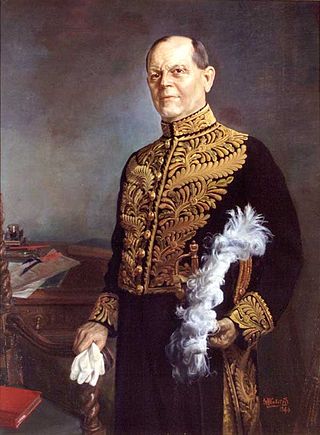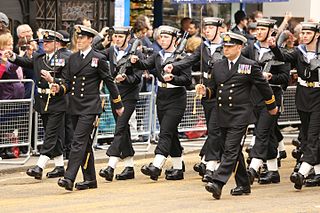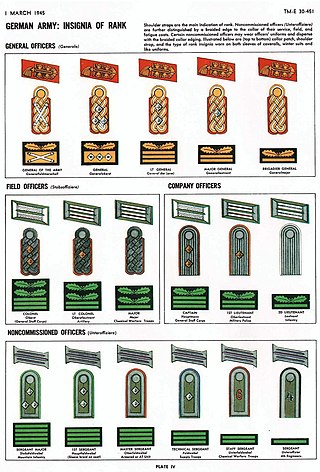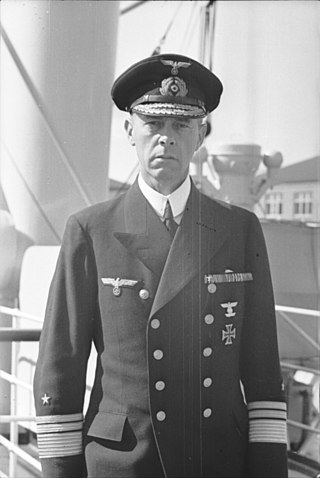
The Order of St John, short for Most Venerable Order of the Hospital of Saint John of Jerusalem and also known as St John International, is an order of chivalry constituted in 1888 by royal charter from Queen Victoria and dedicated to St John the Baptist.
Listed in the table below are the insignia—emblems of authority—of the British Army. Badges for field officers were introduced in 1810 and the insignia was moved to the epaulettes in 1880. On ceremonial or parade uniforms these ranks continue to be worn on the epaulettes, either as cloth slides or as metal clips, although on the modern 'working dress' they are usually worn as a cloth slide on the chest. Although these insignia apply across the British Army there is variation in the precise design and colours used and it can take some time to become familiar with them all.

Mess dress uniform is the most formal type of evening-wear uniform used by military personnel, police personnel, and other uniformed services members. It frequently consists of a mess jacket, trousers, white dress shirt and a black bow tie, along with orders and medals insignia. Design may depend on regiment or service branch, e.g. army, navy, air force, marines, etc. In modern Western dress codes, mess dress uniform is the supplementary alternative equivalent to the civilian black tie for evening wear. Mess dress uniforms are typically less formal than full dress uniform, but more formal than service dress uniform.

The Pontifical Equestrian Order of St. Gregory the Great was established on 1 September 1831, by Pope Gregory XVI, seven months after his election as Pope.

A blazer is a type of jacket resembling a suit jacket, but cut more casually. A blazer is generally distinguished from a sport coat as a more formal garment and tailored from solid colour fabrics. Blazers often have naval-style metal buttons to reflect their origin as jackets worn by boating club members.

Imperial Japanese Army uniforms tended to reflect the uniforms of those countries who were the principal advisors to the Imperial Japanese Army at the time.

The uniforms of the United States Navy include dress uniforms, daily service uniforms, working uniforms, and uniforms for special situations, which have varied throughout the history of the navy. For simplicity in this article, officers refers to both commissioned officers and warrant officers.
Commander, or Knight Commander, is a title of honor prevalent in chivalric orders and fraternal orders.

Court uniform and dress were required to be worn by those in attendance at the royal court in the 19th and early 20th centuries.
The ranks and insignia of the Confederate States were a rank insignia system devised for the military of the Confederate States of America during the American Civil War.

The Commemorative Order of Saint Thomas of Acon is an independent British Christian masonic organisation. Membership is restricted to those who are subscribing members of a Preceptory (Commandery) in amity with the Great Priory of the United Religious, Military and Masonic Order of the Temple of England and Wales and Provinces Overseas. Membership is by invitation only. The basic organisation of the Order is a Chapel.

The Pontifical Equestrian Order of Saint Sylvester, sometimes referred to as the Sylvestrine Order, or the Pontifical Order of Pope Saint Sylvester, is one of five orders of knighthood awarded directly by the Pope as Supreme Pontiff and head of the Catholic Church and as the Head of State of Vatican City. It is intended to honour Catholic laypeople who are actively involved in the life of the Church, particularly as it is exemplified in the exercise of their professional duties and mastership of the different arts.
The International Order of Twelve Knights and Daughters of Tabor is an African-American co-ed fraternal organization best known as the sponsor of the Taborian Hospital.

The uniforms of the Royal Navy have evolved gradually since the first uniform regulations for officers were issued in 1748. The predominant colours of Royal Navy uniforms are navy blue and white. Since reforms in 1997 male and female ratings have worn the same ceremonial uniform.
The military uniforms of the Union Army in the American Civil War were widely varied and, due to limitations on supply of wool and other materials, based on availability and cost of materials. The ideal uniform was prescribed as a dark blue coat with lighter pants, with a black hat. Officer's ranks were denoted with increasing levels of golden decoration. Specific jobs, companies, and units had markedly different styles at times, often following European customs such as that of the Zouaves. Officers uniforms tended to be highly customized and would stray from Army standard. Ironically, several main pieces of gear had been created by order of the U.S. War Secretary Jefferson Davis before the war; he later became Confederate President.

The Royal Montserrat Police Service is the police service of the British Overseas Territory island of Montserrat in the Caribbean.

The Heer as the German army and part of the Wehrmacht inherited its uniforms and rank structure from the Reichsheer of the Weimar Republic (1921–1935). There were few alterations and adjustments made as the army grew from a limited peacetime defense force of 100,000 men to a war-fighting force of several million men.

The Kriegsmarine was the navy of Nazi Germany prior to and during World War II. Kriegsmarine uniform design followed that of the preexisting Reichsmarine, itself based on that of the First World War Kaiserliche Marine. Kriegsmarine styles of uniform and insignia had many features in common with those of other European navies, all derived from the British Royal Navy of the 19th century, such as officers' frock coats, sleeve braid, and the "sailor suit" uniform for enlisted personnel and petty officers.

Royal Navy ranks, rates, and uniforms of the 18th and 19th centuries were the original effort of the Royal Navy to create standardized rank and insignia system for use both at shore and at sea.




















